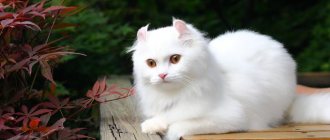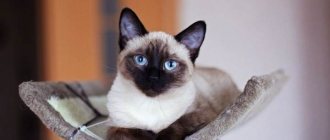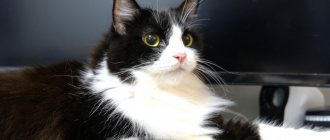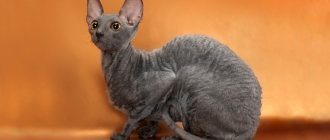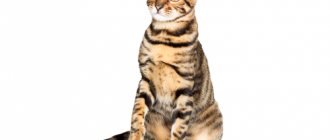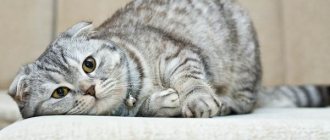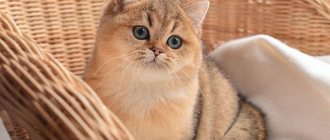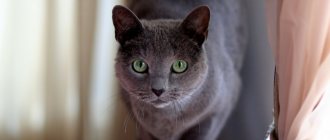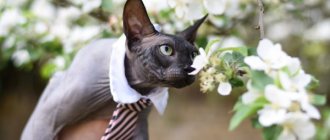Home » Breeds » About the Chausie cat breed
Let me introduce to the public another very rare and extremely beautiful breed of cat - Chausie. Photo.
Let’s not hide the fact that this is an interspecific hybrid of the domestic Abyssinian and the wild reed cat, the Hausa.
Advantages and disadvantages
- Pros:
- unusual appearance;
- friendliness and affection for the owner;
- getting along with children and pets;
- playfulness, energy;
- absence of genetic diseases.
- Minuses:
- high cost of kittens;
- hyperactivity and excessive curiosity;
- picky eating habits;
- impossibility of further breeding of purebred cats;
- the need for space in the home.
a brief description of
An extraordinary cat breed
The Chausie breed can be briefly described as follows:
| Index | Rating on a 5-point scale |
| Interaction with children | 3 |
| Attitude towards strangers | 3 |
| Financial costs of maintenance | 4 |
| Health status | 4 |
| Price | 5 |
| Dietary requirements | 2 |
| How much do they shed? | 3 |
| Difficulties in care issues | 3 |
| Need for communication | 2 |
| Aggression level | 3 |
| Mobility | 4 |
| Intellectual development | 4 |
| Dimensions | 5 |
| Cleanliness | 3 |
Chausie's characteristics are compiled based on reviews from owners and expert opinions. The information is averaged and may change in one direction or another.
Key facts
The Chausie, or Houseie, breed was recognized five years after its appearance. She quickly gained numerous fans around the world, but even today there are few individuals. Shawsie cats are found in America, less often in European countries. In the former CIS countries there are very few Houses, which is why the cost of kittens is very high.
Description of the Chausie breed combines elegance, grace, mystery, beauty, cheerfulness, a kind and accommodating disposition, and a strong attachment to the owner and his family. The pet always tries to be visible and take part in everything that happens around.
Chausie owners claim that the cat’s character contains habits typical of dogs: it can be taught to walk on a leash and fetch small toys. The cat can even learn simple tricks from the training course.
Characteristics of the Chausie breed include the following factors:
- Country of origin: North America, late 60s – early 70s. last century.
- Registration - 1996 by the International Cat Association.
- Character traits - activity, energy, devotion to owners, getting along with children and other pets.
- With proper care and proper nutrition, the life expectancy of a Chausie cat is about 13 years.
- Care - to keep a Chausie you need 3 things: financial capabilities, enough free space in the home, the ability to devote a lot of attention and time to the cat.
Chausie does not tolerate loneliness well, showing excessive anxiety. She should not be left alone for long periods of time. An active cat is happy to participate in outdoor games; it can be placed in a house with a dog and decorative rodents.
History of the origin of chausie
The Chausie is a cat breed that retains the spirit of both ancestors. Unlike artificial breeds obtained by gene mutation, this pet is all naturalness.
The name “chausie” was given to the mustachioed cat from the name of the swamp cat (in Latin, Felis chaus). Almost a meter tall predator weighing about 22 kg lived in Africa, South Asia and the Caucasus. People have long tried to tame the domestic cat and, to some extent, they succeeded.
Chausie cats are the result of crossing a domestic cat and a swamp cat. The Abyssinian was usually used as the first, so at first glance the Shawsie can be mistaken for Felis catus (domestic cat).
The exact date of the appearance of hybrids is unknown, but there is an opinion that the first “experiments” in breeding the breed were carried out by Americans in the early 70s of the last century. But they were never crowned with victory, since the gorgeous cats degenerated in subsequent generations.
To consolidate the phenotype, short-haired “yard” cats were involved in Chausie breeding. But even today, the wild characteristics of the swamp ancestor can be preserved in descendants only up to the fifth generation, which explains the exclusivity and high price of kittens.
Unlike other cat breeds, Chausie cannot be accurately characterized without reference to generation, which is designated by the letter “F” (from Italian “Figli” translates as “children”), the number is displayed in numbers 1, 2 ... 5.
Thus, the F1 generation Housie was obtained by crossing an Abyssinian cat and a wild swamp cat. F2 is a hybrid of the next generation, where the grandfather is a jungle cat (the share of wild blood in the animal is no more than 25%). F3 – no more than 13% of the original genes remain from the swamp cat, F4 – no more than 7%, F5 – about 4%.
In the 5th generation, the external resemblance to a swamp cat practically disappears, and the descendant has characteristics of an Abyssinian, or less often, an ordinary yard cat. It is noteworthy that in the F1 litter, when a jungle cat is mated to a mongrel cat, Shawsie kittens with a large number of infertile males are born.
When F1 housezi are crossed with each other, the offspring often turn out sick or nonviable. In short, at this point in time there are many difficulties with breeding the breed that breeders still have to overcome.
Breeding cats
Breeding Chausie is difficult if you do not have certain skills. A breed with an excellent gene set, but infertile cats are often found. Cats are most susceptible to this. Sometimes, after the first mating they become incapable of procreation. Cats remain reproductive longer. The main thing is to choose the appropriate partner. In this regard, Abyssinians of tekked or wild color are suitable. Only then will purebred Chausies be born.
Abyssinian representative
If the partners immediately liked each other, then after 70 days kittens appear. There are usually 2-5 of them in a litter. During pregnancy, cats do not require any special treatment, with the exception of an individually developed diet that includes vitamins and microelements. It is preferable to look for Chausie for mating in specialized nurseries.
What does a chausie look like?
Chausies are quite large animals, second in size only to the Maine Coon and Savannah. At the withers, pets reach 42 centimeters. Males are slightly larger than female cats, this difference is due to sexual dimorphism. A purebred cat resembles its ancestor and weighs at least 16 kilograms. But the further away the generation of the wild ancestor, the smaller the descendants.
Muzzle
As you can see in the photo, the Chausie's head is small, slightly elongated, with angular cheekbones and a pronounced chin. The main difference between the breed is the presence of a mark above the eyes - the letter “M” and between the ears - “W”.
The ears are quite large and set high on the head. There are tassels at the ends, but if they are not there, then this is not considered a defect. The slanted eyes are golden or greenish in color. The cat has a quiet voice, he purrs gently and with pleasure.
Body type
The Shawsie's appearance has the confidence and strength of a predator. The body is muscular, the sternum is well developed, the paws are athletic, quite large and long, the tail is equal in length to three-quarters of the cat’s body.
The skeleton is developed, the shoulder blades are located high and well defined - the pet’s movements are similar to the running of a cheetah. Medium-length forelimbs and long, proportional hind legs create a strong push. The cat's posture is semi-crouched; there is a loose fold on the stomach, allowing the animal to move with wide strides.
Coat and color
Thick, short, fairly elastic coat repels dirt and water well. It is silky, the guard hairs are ticked.
The varieties of Chausie cats in terms of color tones are few in number. In nature, you can find only 3 colors of Chausie: completely black, ticked silver and tabby (striped brindle). The most valuable is a cat with a silver ticked tabby and a black ticked tabby color, which resemble the coloring of a wild ancestor.
Description of the breed
Compared to ordinary kitties, Chausies seem like baby elephants.
The appearance of these cats cannot be confused with other individuals. In some countries they are called "swamp cats". Chausie can be considered a large animal - the weight of an adult individual is up to 16 kg, with a height at the withers of up to half a meter. They have developed body muscles. Cats are bigger than kitties.
Breed standard:
| Head | Wedge-shaped, small in size compared to the body. She has graceful features, no angularity or sharp outlines. The forehead is massive and flattened. On the top of the head there are large ears, spaced quite widely. They are wider at the base, with pointed tips and brushes. |
| Muzzle | Pretty, compact. The nose is straight, the transition line to the forehead is clearly visible. The jaws are strongly developed and strong. They have a scissor bite. |
| Torso | A powerful, long neck is immediately visible. Cats are dense in constitution, with clearly visible muscles. Wide chest and narrow shoulders, toned stomach. The back is straight throughout. |
| Tail | Straight, elongated and flexible. He is very mobile. |
| Limbs | Slender, graceful, thin. The fingers on the pillows do not touch tightly. |
| Wool | Short, dense, with undercoat. Visually it seems plush. Glistens under the sun. |
Chausie character
The main feature of the house is that they incredibly combine a sweet, kind pet and a wild animal. By nature, Chausies are self-confident, completely independent cats with absolute friendliness and self-esteem. They are strongly attached to the owner and all other household members.
The presence of smaller animals is allowed in the apartment - Chausie gets along well with them. The dog will also not become a hindrance in getting such a pet: the cat will begin friendship with it on a full-fledged basis.
Shawzies are incredibly smart and easy to train. Cats enjoy being in the company of people or watching them from above. Large dimensions and fairly heavy weight do not allow the animal to sit comfortably on a person’s lap, but it will be enough for them to rub their head against the owner’s legs. Animals also receive pleasure from light scratching behind the ears, stroking the back with a hand and other types of attention.
Cats have retained this quality of making provisions for a rainy day. Unnoticed, they will hide part of the portion in a secluded place, as their ancestors did in the wild. Be prepared for the possibility that an unpleasant odor may appear in your home from the most unexpected place.
Cats love to sit on a high place and watch what is happening. This feature is inherent in many mustachioed cats, but when a 16-kilogram cat jumps onto a shelf, a piece of furniture simply may not withstand the load. Therefore, before getting such a pet, securely fasten all structures and remove fragile interior items.
Coat colors
Dark color Chausie
The peculiarity of such cats is their color. The guard hairs are unevenly colored in certain areas of the body. The standard provides several colors:
- Resinous. The animal is almost completely black. There are rarely any markings.
- Tecked black tabby. The fur is multi-colored, the undercoat is of a reddish-golden hue on the paws and tail along the inner surface. The chin and eye contours are lightened.
- Black with silver. The guard hairs have several stripes, usually silver or black. Deeply colored points in tabby will be considered a defect.
- In addition to the listed colors, there are others, but they are less popular. Such individuals are not allowed to reproduce.
Raising a Chausie
Raising a Chausie should be done from the first days of the kitten's appearance in the home. Pets have developed intelligence, they quickly learn to understand the owner and carry out all his commands. The owner must maintain a balance and give the baby enough love, care and attention. without forgetting about the animal’s personal space. To raise a kind and obedient animal, you need to respect its desires and free will.
Initially, train the kitten to use the litter box. Patience and perseverance will be required, since the appearance of puddles in your home is inevitable. The main success factors are the correct selection of a place for the cat litter, the type of litter and attention to behavior in moments of anxiety. You can also train your pet to use the toilet - for this, a set of special devices is sold in the pet store.
No less attention should be paid to introducing the baby to a scratching post - with its sharp claws, an animal can damage pieces of furniture, clothing, wallpaper, and more. By accustoming your pet to a scratching post from the first days of living in the house, you will protect your things from damage, and the kitten from developing a bad habit.
Every attempt at mischief must be immediately stopped by shouting loudly, clapping your hands, or spraying water. In exceptional cases, you can use light physical punishment - a weak slap on the back with a wooden stick or newspaper will make it clear to the kitten that this cannot be done.
Particular importance in raising chausie should be given to causing harm to the legs, arms, and other parts of the human body. From the first days of living in the apartment, the cat is made to understand that these are not toys, and under no circumstances should they be scratched or bitten.
Shawzi should also be taught hygiene. Periodic brushing, washing, and examining eyes, teeth, and ears should become routine procedures for your pet. Equally important is the socialization of the baby - they put a leash and harness on him and first lead him around a confined space, after which he is introduced to the surrounding nature and other animals.
Chausie health
The Hausie breeder is lucky - the animals are endowed with excellent health, but have sensitive digestion and are prone to obesity. From their ancestors they received resistance to infectious diseases, and timely vaccination can significantly increase immunity.
The first vaccination against panleukopenia, rhinotracheitis and calicivirus is given to a cat at the age of 9-10 weeks, and it is repeated after 30 days. Until the age of one, a rabies vaccine is also administered. Vaccination should be preceded by a course of worm prevention - 2 weeks before vaccination, the baby is given an anthelmintic drug.
Possible diseases
If your pet's diet includes raw meat, deworming should be done regularly. Frequent walks in nature require treatment of the coat with flea and tick repellents.
With proper care and nutrition, the health of the Chausie throughout its life is not of particular concern. Annual visits to your veterinarian are recommended to perform a general examination and detect problems at an early stage of development.
Reproductive health
Breeding Shawsies is not an easy task. Even in an F1 pair, the valuable genetic qualities of the parents will be reduced by half in the next litter. This will be noticeable in the appearance of the descendants.
In general, Chausie cats do not produce equally purebred offspring: the babies often turn out to be completely ordinary. A successful breeding result is rather an exception to the rule. In addition, cats from both F1 parents are almost always sterile. This is what makes the breed so expensive and rare throughout the world.
If the cat becomes pregnant, then everything proceeds according to the usual scenario. The duration of pregnancy for a Chausie is 60 days. Kittens that are born before this period are premature and often die.
Shawsies usually give birth to 4-6 kittens. You can give birth yourself, having prepared the place, necessary supplies, instruments and medications - or invite a doctor.
If breeding cats is not planned, it is recommended to perform sterilization or castration. By surgical intervention, the testes of cats are removed, and the uterus and ovaries of cats are removed. After this, the animal loses the ability to reproduce offspring and becomes calmer and more affectionate.
Features of feeding and diet
The nutrition of the chausie should be given special attention. Pets definitely won’t eat food waste; the ideal solution is to buy premium and super-premium dry food.
If you plan to feed the Chausie with natural food, then the daily diet should include:
- raw, boiled pork, beef, chicken meat;
- sea and river fish without bones;
- chicken eggs;
- curdled milk, low-fat cottage cheese, sour cream, fermented baked milk, kefir;
- cereal porridge;
- fruits, boiled and raw vegetables, greens;
- vitamins from a veterinary pharmacy.
The diet must be composed correctly, as animals are prone to overeating.
Clean water should be freely available and in the required quantity. Boiled liquid is not suitable - it can lead to the formation of stones in the bladder and kidneys. It is wiser to give your cat bottled water.
A kitten should be fed 3-4 times a day, teenagers - three times a day. In the first case, they give 220 grams of feed per day, in the second - 250 grams. Adult animals are fed 2 times a day, the total amount of food should not exceed 440 grams.
Catering
Chausie's passion for raw meat is in his blood. A large, juicy bone that can be deliciously torn into pieces is not only a favorite delicacy, but also an opportunity for a chausie to feel like a wild animal.
Natural products
The main food for chausie should be the following products:
- Meat. Raw is the most delicious, but the unprocessed product may contain parasite larvae and pathogens. Therefore, first thoroughly freeze the piece in the freezer (at least 2 days), then defrost it and pour it over with boiling water. You cannot grind it into mince: the cat must massage the gums, and the soft mass will not allow this. Allowed types: veal, beef, chicken, turkey, rabbit, horse meat, kangaroo meat, quail meat. If you have the opportunity to buy feed mice and day-old chicks, they are fed without treatment.
- Offal. These are poultry, beef and turkey hearts, liver, chicken stomachs, cartilage, necks, chicken heads, tongues, kidneys, lungs, udder, spleen, beef tripe. They are combined and mixed with vegetables.
- Fish. An excellent source of protein, vitamins and fatty acids. Acceptable species: hake, flounder, blue whiting, sea bass, trout, chum salmon, pink salmon, salmon, pike perch, tench. It is better not to feed fatty fish (saury, ivashi, saberfish, silver carp, eel, herring).
- Dairy products. These are cottage cheese, kefir, yogurt, natural yogurt - given as a treat 2-3 times a week. Cottage cheese can be mixed with a boiled quail egg or boiled chicken yolk (the white can cause intestinal upset).
- Vegetable stew. Carrots, beets, zucchini, broccoli, asparagus, herbs (parsley, dill). Some animals are not averse to gnawing on a fresh cucumber, watermelon or melon.
In addition to food, cats need to be given vitamins and minerals (choose a good complex), as well as yeast tablets.
Chausie cats are fed 2 times a day: at 7-8 am and 6-7 pm. Snacking between meals is best avoided.
Chausie drinks often and in large quantities, so give him not one, but two bowls, and change the water 2 times a day. It is better to take purified liquid: distilled or settled. Tap water is harmful to a cat's stomach.
Expert opinion
Dusheba Vera Ivanovna
In 2010, she graduated from the Moscow State Academy of Veterinary Medicine named after K.I. Scriabin with honors, specializing in veterinary medicine. I regularly attend veterinary conferences, congresses, and webinars.
It is strongly not recommended to feed Chausie cats with dry food and cereals!
Chausie should not be given to:
- fat meat;
- human drinks: alcohol, juices, tea, coffee, cocoa;
- pickled, fried, salty, sweet, sour, smoked foods;
- citrus;
- legumes, potatoes, tomatoes, eggplants, grapes, dried fruits;
- whole cow's milk;
- mushrooms, nuts;
- dog food.
You can give baked goods and flour, but rarely and little by little.
Care and maintenance
When giving preference to the Chausie breed, remember that these are active, energetic, curious pets that require constant attention and free space for active games. They definitely won’t sit in one place.
The ideal place for keeping is a spacious courtyard of a private house, where cats can freely walk and climb bushes and trees. If this is not possible, you should think about arranging your home.
The apartment in which the chausie settles should be spacious. The breed is impressive in size and loves to jump and run. Free space for such movements must be required. In addition, the animal must be regularly walked outdoors using a leash and harness.
Cats are similar in character to dogs - they can be taught to fetch small objects and follow voice commands. They are overly sociable and need increased attention from family members. At the same time, the pets are incredibly dexterous and jumping. All breakable things in the home should be hidden, and pieces of furniture should be well secured.
For games, you can equip your apartment with ladders and special houses where you can climb, hide and watch from above what is happening around you. This is how the ancestor of the Howzi, the swamp cat, behaved. It is imperative to have a scratching post in the house, otherwise sofas and carpets will be scratched by the strong and sharp claws of the animal.
Chausies enjoy playing with small children without injuring them or getting offended by pranks. If there are no children in the family, the owner needs to be prepared for the fact that he will have to entertain the pet himself - there should be interesting toys in the house: balls, rustling toys, fishing rods, mice. Having other pets who will definitely make friends with the sociable and cheerful cat will also help in this matter.
In general, caring for and maintaining the Chausie is not particularly difficult. Animals do not have a specific smell, their fur is thick and hard, practically does not get dirty, and it is enough to comb it 1-2 times a week. The massage brush perfectly removes dead hair and improves blood flow.
Cats also like bathing – this hygiene procedure can be performed with pleasure. But you shouldn’t overuse it either, as you can wash out all the natural fat from the wool. Regular examination of the animal’s ears and eyes and removal of wax and foreign deposits with a damp cloth are also useful.
The oral cavity of the chausie also requires no less attention: heavy plaque and stones on the teeth can lead to the development of caries and swelling of the gums. For prevention, the cat is allowed to gnaw on cartilage and bone tendons - they naturally clean the dental tissue. Regular brushing of teeth with a special paste is also recommended.
Tips for choosing a kitten
Before purchasing a Chausie kitten, you need to immediately understand that getting from him purebred offspring with the characteristics of the parents is out of the question, since the value of the next litter is lost by half. As you move away from F1, the unique qualities of wild cats, their size and weight, decrease.
When getting an elite breed, you need to understand that this is a “disposable” elite pet, and it will not be possible to fully compensate for the costs by selling kittens. In addition, today you cannot buy Housei in the Russian Federation and CIS countries; there are official nurseries only in America and France.
If you are offered to buy a “purebred” Chausie cat on an online ad site, rest assured that you are dealing with scammers. A purebred kitten can only be purchased from an official breeder. To do this, you will have to send an application and wait 3-4 months for the next brood.
It is better to entrust the purchase of a kitten to a specialist with a good reputation. He will contact a time-tested foreign breeder and, with all the accompanying documents, will deliver the baby straight home to the new owner.
Reproduction
In many ways, Chausies are so expensive also because they are very difficult to breed. The fact is that in most cases, male kittens in the upper classes (primarily F1 and F2) are sterile from birth.
For this reason, independent breeding, and even in our conditions, where chausies are practically never found, can be considered a matter of the greatest difficulty. The most that can be done is to cross a high-class cat with ordinary domestic cats, producing kittens of class F2 and below. In general, the mating procedure is completely similar to a similar procedure for any other breeds, but it should be taken into account that a semi-wild animal can offend a too timid and domestic cat.
If you have a Chausie cat of a fairly high class and you still decide to cross it with other breeds, please note that in order to preserve the color and most other breed characteristics, you must carefully choose a partner for mating. The best candidate is a representative of the Abyssinian breed, since it was this breed that breeders usually took for crossing with reed cats. Bengal cats and representatives of some short-haired breeds can act as a possible, but still not the best alternative.
Bengal cats and representatives of some short-haired breeds can act as a possible, but still not the best alternative.
Another big problem is that the “wild” genes in cats of the lower classes are no longer dominant, which is why most kittens look completely ordinary, so they have to be carefully selected.

